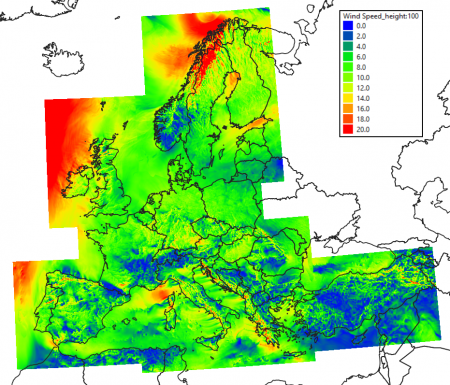New European Wind Atlas (NEWA)
Introduction
The New European Wind Atlas (NEWA) is a high resolution mesoscale dataset that was modelled and provided by the NEWA consortium. NEWA was established as an ERANET+ project with a total budget of 13.1 million euros and it was executed over the years 2016-2019. One of the project outcomes was a comprehensive mesoscale modelling with a spatial coverage of the whole of the European Union and Turkey - and extending at least 100km from any known coastlines. 10 years of data has been made available in a temporal resolution of 30 minutes. A total of 1.37 million individual data-nodes (points) are instantly available from within windPRO.
Dataset Overview
- Content: Limited feature subset of the NEWA mesoscale dataset - but full spatial coverage (1.37 million nodes).
- Spatial resolution: 3km
- Temporal resolution: Timestep 30 minutes
- Coverage: European Union and Turkey (see the map to the right)
- Period: 10 years of data from 2009-01-01 to 2018-12-31
- Update schedule: This dataset is not updated
Usage Notes
- I am interested in other parameters. Where can I get those? See a complete list and download these directly from the NEWA homepage: https://map.neweuropeanwindatlas.eu (time-series download is not directly possible)
- Why is only 10 years of data available?: The mesoscale modelling in the NEWA project covered 30 years (1989-2018) - but currently only the last 10 years has been made available to the public from the NEWA consortium.
- Where can I learn about the performance of the data?: The NEWA data was included as part of the EMD data benchmarks for the EMD-WRF Europe+ dataset. Here different reanalysis and mesoscale data sources were compared to 300+ high-quality masts within the European domain. The validation report is freely available - here.
- How can I get turbulence intensities from the NEWA data - as only the Turbulent Kinetic Energy (TKE) is given as a parameter?: As of October 2021, windPRO does not support the use of TKE as a turbulence parameter. However, you can use a (manual) procedure to convert it - by the use of Microsoft Excel or a similar spreadsheet. A procedure is suggested here.
Dataset Parameters
The following parameters are available from the NEWA mesoscale data-subset in windPRO:
| Parameter(s) | Description | Unit |
|---|---|---|
| time | UTC time stamp | YYYY-MM-DD HH:MM |
| T.100, T.200 | Temperature in 100m and 200m agl | degK |
| TKE.100 | Turbulent Kinetic Energy in 100m agl | (m/s)^2 |
| WD.100, WD.200 | Wind direction in 100m and 200m agl | deg |
| WS.100, WS.200 | Wind speed in 100m and 200m agl | m/s |
License and Attribution
This dataset is a subset of the NEWA mesoscale dataset that has been released under the Creative Commons By Attribution 4.0 license (CC-BY-40) - https://creativecommons.org/licenses/by/4.0/. As a part of the license conditions, the data-owner requires an attribution, such as:
Source: Data obtained from the “New European Wind Atlas, a free, web-based application developed, owned and operated by the NEWA Consortium. For additional information see www.neweuropeanwindatlas.eu". Distribution through EMD and windPRO - EMD International A/S, 2021. License: CC-BY-40.
Required windPRO License and Modules
This dataset can be accessed from the most recent version of windPRO given that you hold an active service agreement and a license to the following modules:
- BASIS
- METEO
External Links and References
- NEWA - main homepage: https://www.neweuropeanwindatlas.eu
- NEWA - map and data: https://map.neweuropeanwindatlas.eu
- NEWA - Model setup: https://map.neweuropeanwindatlas.eu/about
- NEWA - Mesoscale publication: https://zenodo.org/record/2682604#.YT7qZH3RYUE
Acknowledgement and Credits
- Credits and Acknowledgement: The NEWA Consortium for the release of the NEWA mesoscale dataset as a free and open dataset.
- Integration of this dataset into EMD services was co-supported through the RECAST project (http://www.recastproject.dk) which is co-funded by the Danish Innovation Fund
